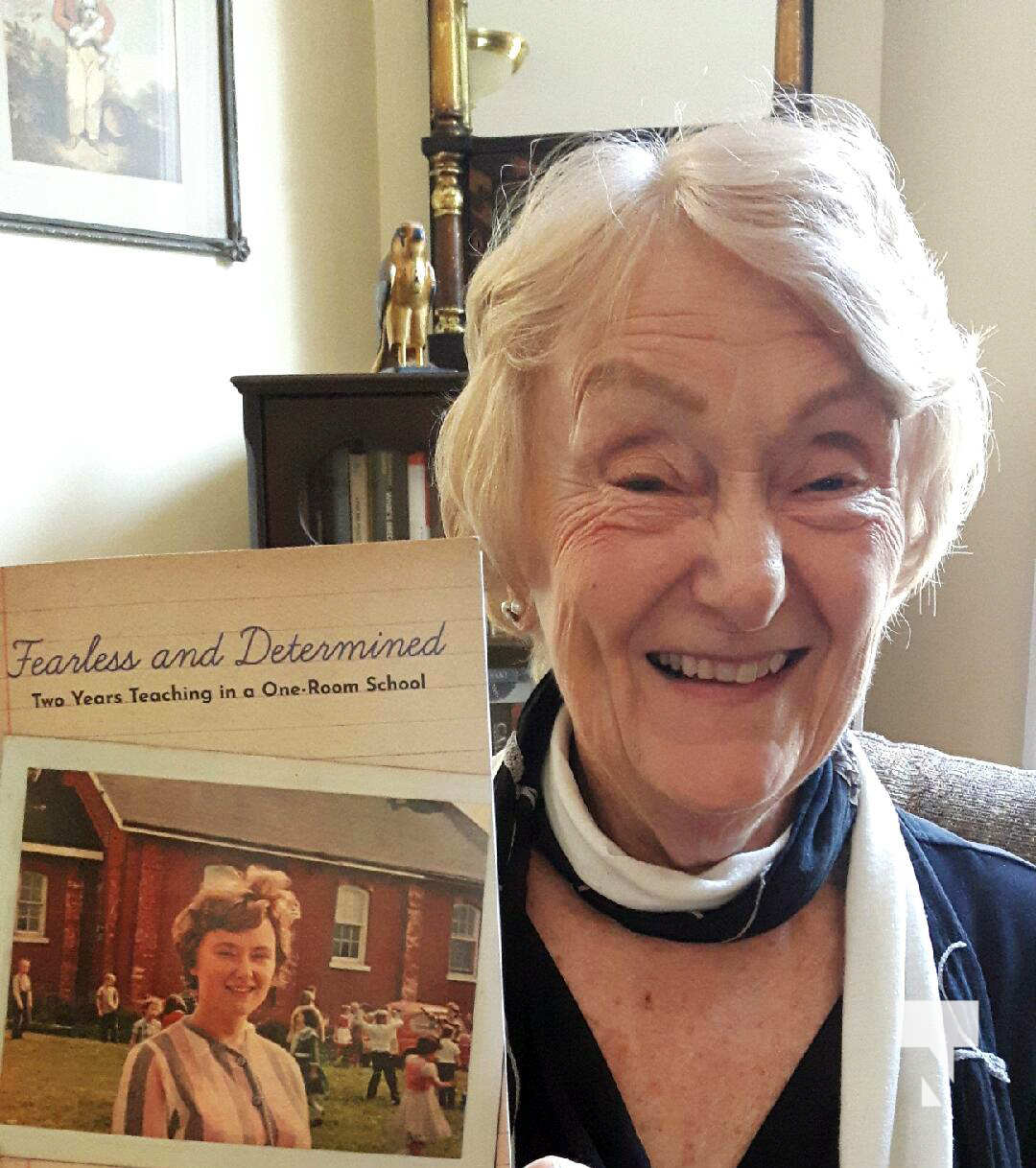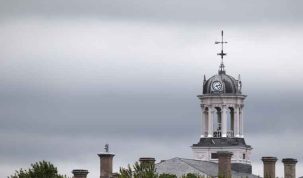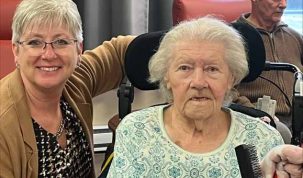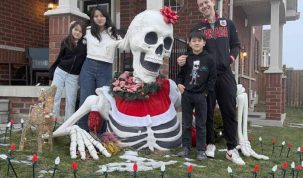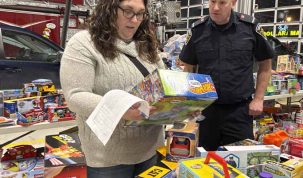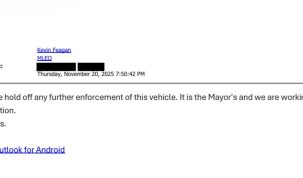By Cecilia Nasmith/Today’s Northumberland
Those good old schooldays in the good old one-room schoolhouses were the reality of many Northumberland residents who attended a widely scattered network of these bare-bones institutions of learning before consolidations into larger, more modern schools closed them all.
Hamilton Township author Linda Hutsell-Manning, who attended just such a school in Baltimore, went on to have the opportunity to teach in one – and those two unforgettable years are the subject of her newest book Fearless And Determined (summing up her response to what she considers one of the most challenging times of her life).
SS 2 Hamilton Township was known colloquially as the Front Road school for its proximity to County Road 2 – which was not then the major artery it is now and was generally known as the Front Road. It was located west of Theatre Road on the south side of the highway just east of what is now Ray Lane’s garage.
It sat in a field, she said, with basically nothing between the school and Theatre Road. This is where she taught for the 1963-64 school year and the one after that.
Hutsell-Manning cherishes what was the official yearbook of that first year, one of those large-format old-fashioned scrapbooks you could pick up at the Woolworth’s store that she packed chock-full of history that both inspired and facilitated her in creating this book.
“It chronicles everything we did,” she said, leafing through its pages with obvious pleasure.
Much of it was written by her students, including their own profiles. With a grinning black-and-white school picture of each student topping each page in this section, she had each of them write their own profiles, which had to include name, grade and what he or she liked best.
Students also wrote up many of the accounts of school life that amazing year, from holiday celebrations to a Beatlemania tribute concert, all illustrated with amateur black-and-white photography.
One page has a drawing of a table lamp. Somebody donated that as a fundraiser, Hutsell-Manning reported. They raffled it off and earned $30 toward the school field trip to the Thousand Islands and Old Fort York.
She couldn’t recall arranging the details of that trip, until she spoke with someone who had worked as a secretary for the old Burley Bus Lines in Cobourg. They chartered a Burley bus for that excursion, the woman reminded her, and the Burley company took care of all the tickets and other arrangements.
The account of the baby starling they found still touches the heartstrings, Hutsell-Manning said. The baby bird was found against the school’s east wall by a compassionate Grade 6 student named Wolfgang. A classmate passed along his dad’s warning, that starlings were a curse. With a wisdom beyond his years, young Wolfgang responded that the little bird couldn’t help the fact that it was a starling.
Wolfgang soon organized the care of the bird with brisk efficiency, certain classmates assigned to fetch and chop its worms and a rotating schedule for different students to take it home over the weekend. Eventually it learned to fly and, after a final weekend at Wolfgang’s house, they staged an emotional release for the fledgling starling.
Another traumatic event came Nov. 22, 1963, when Hutsell-Manning was joined by a couple of young students who skipped lunchtime recess to help her with some paperwork. They turned on the radio, expecting to hear the Beatles, and instead heard a blow-by-blow unfolding of President Kennedy’s assassination.
The girls were too upset to continue helping and wandered outside – and Hutsell-Manning heard the sounds of students at play gradually fade away as the news made its rounds. The students filed quietly back inside to hear more of the news on the radio.
One young boy wondered if the bad guy who did this terrible thing might come to get them. As a true teacher would, Hutsell-Manning displayed a map, pinpointed their location in relation to Dallas, Texas, and did the calculations – it would take a five-day drive for the assassin to reach them, she was able to tell the troubled student.
There were smaller traumas too, such as the smallpox shots and the polio vaccines administered to the children on cubes of sugar. But the celebrations and jubilation reflected in the writing and photos far outweigh these somber times.
Hutsell-Manning calls her memoir creative non-fiction, and some of this approach comes into play regarding her second year at the school – which had no scrapbook documentation. She was simply too busy – pregnant with her second child and involved in a Queen’s University psychology correspondence course she was taking as well as teaching full-time.
“In those days, you couldn’t be pregnant and teaching,” she recalled.
“However, as I was the principal, I had a discussion with myself and said it was perfectly all right. I was doing really well, and they liked me – and it was the last year the school would be there.”
These odd attitudes of the times were reflected in her original interview for the job, she recalled.
Though she’d been to teacher’s college, she hadn’t had the opportunity to teach at that time because she got married and had her oldest child. This lack of experience hampered her getting a job at a Cobourg school, but she did manage an interview for the SS 2 job at Cold Springs Memorial Hall (which was then Hamilton Township’s municipal building).
The men interviewing her seemed more interested in her father-in-law’s career as a local insurance salesman and who had been her teacher when she went to school in Baltimore than her qualifications. One man remembered seeing her tap-dance at the old Baltimore Community Centre and complimented her on the performance. No questions about her teaching ability, she recalled.
Hutsell-Manning soon found herself in charge of a one-room facility with two pit toilets in front, a cold-water tap, a wood stove and six large windows (which she initially loved, until winter came and there were no storm windows to overlay them). The library was a large floor-to-ceiling bookcase that looked like no one had opened its glass doors in a generation.
No curriculum came with the job, she said – just a report card listing the subjects. She had to make her own curriculum. She improvised to enrich it where she could, with providing her own books to read to the children and her own music to play for them.
During her second year, she came to the realization that some of her students came from poor families. With that, she started her own soup program. Someone donated a hot plate, she brought in a big pot and things got rolling.
Many of her students still remember having to bring in their own cups and spoons, and having to wash them after.
She set out a box and put $5 in it to encourage donations. Some of the children came through generously, and she figured these were the students from well-established, comfortable farming families. But there definitely were children from poorer families too, and she was glad she could think of something to help.
The days began at 7:30 a.m. for her and might last 10 hours or more. One task she didn’t have to worry about, however, was the wood stove. The Carr family (of the Carr’s Honey business) had attended that school for generations – as they lived nearby, they were happy to get the stove going in the morning for her.
Her blackboards were constantly filled with work for the older students to free her for working more closely with the younger ones. And the older students who could finish up their work more quickly and lend a hand with this were a godsend, particularly those who were capable of helping her put a dent in those stacks of scribblers waiting to be graded.
Then there were those students who finished a day’s work by 10:30 a.m. but were not particularly inclined to help. For these students, she would create advanced curricula or special educational projects.
For phys ed, she adapted the 10 BX fitness program the military developed for its women enlistees to get the students stretching and touching their toes. When someone brought in an old mattress, she added forward rolls to the routine.
“Every day was a huge scramble to try to get everything done, and I was always behind. But the students really liked me, and I really liked them. We became a family, and we had a good time.
“It was a very interesting journey going back there,” she said.
Among the research she undertook, Hutsell-Manning had the pleasure of interviewing 18 former students.
“What they told me that I didn’t remember!” she said.
She also unearthed little to nothing in terms of documenting what life was like in the old one-room schoolhouses that were once so common throughout the land. There’s a wealth of information about one-room schoolhouses prior to the Second World War, but practically nothing about this form of education in the 1950s and ’60s.
And nothing much remained from her old school to help her. The building is gone and, as far as she can tell, all its contents were thrown away. It’s regrettable, she said.
“Just to keep the ledger books would have been interesting.
“Over the front door there was a stone that said, ‘Erected 1860 – Knowledge Is Power.’ I found that stone in somebody’s patio – broken.”
Jennifer Bogart of Let’s Talk Books has told her local readers are keen on local social history, so she foresees an enthusiastic response to the book. And in her own talks with so many people, it seems everyone has a friend or relative who went to a one-room schoolhouse or perhaps taught in one.
The photo on the cover is quite a find, and even that has its own story.
Schools had no phones in those days, she recalled. And on her sixth day of teaching, there was a knock on the schoolhouse door. It couldn’t be the inspector, she figured, not on her sixth day. Instead, she found a bearded man with two cameras who wanted to do a feature for the Toronto Star weekly magazine.
She told him she was too busy, and he’d have to wait until recess. She figured he’d give up and go away, but he was waiting at recess time to take the shot that would be on a November 1963 cover of the Star Weekly. It’s a wonderful shot, she said, and some of her former students can actually identify themselves.
Finding her own path forward after the school closed at the end of the 1964-65 year was quite a journey. Not only was she out of a job, she said – she hadn’t done particularly well in that psychology course, so she ruled out going back to university.
But her creativity and resourcefulness had grown through those wonderful two years of coping with the challenges of that one-room schoolhouse. She went on to take supply-teaching assignments on a limited basis but, going forward, she would devote her energies to writing. She now has a body of work to her credit that includes plays, poems, stories and a number of books for readers of all ages.
Copies of Fearless And Determined will be available Oct. 1, at Let’s Talk Books in Cobourg. Furby House Books in Port Hope and Lighthouse Books in Brighton.
A wonderful book launch is planned Oct. 9 from 7 to 9 p.m. in the Art Gallery of Northumberland (third floor west at Victoria Hall in Cobourg). The event will feature live music by guitarist Philip Hughes, who couldn’t turn down Hutsell-Manning’s request once he learned what the book was about. Hughes told her he had attended that school in 1960, when his parents first came from England and were working for the Burnham family.
As a member of the Ontario retired-teachers’ association, she rates an article in their Renaissance magazine about her book. Watershed magazine will be doing a review in their winter issue, and she has several Probus Club and Rotary Club speaking engagements to share these wonderful stories.
The book is published by the local Blue Denim Press company, and its back cover bears four testimonials – from local authors Shane Joseph and Ted Staunton and from writers Sylvia McConnell and Shelley Leedahl.
Hutsell-Manning hopes to arrange a book signing for local fans in addition to her Oct. 9 launch, and a review – a very nice one, she said – has already been posted by Amazon (which, in addition to Indigo and Chapters, will be selling the book on-line).


